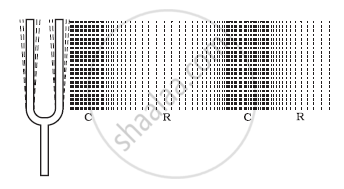Advertisements
Advertisements
प्रश्न
Describe with the help of a diagram, how compressions and rarefactions are produced in air near a source of sound.
उत्तर

Let us assume that a tuning fork is the source of sound.
- When it vibrates and moves forward, it pushes and compresses the air in front of it, thus creating a region of high pressure. This region is called compression (C).
- This compression moves forward away from the vibrating object, such as the tuning fork.
- When the arm of the tuning fork vibrates back inwards (backwards), a low-pressure region is created, which is called rarefaction (R).
- When an object vibrates this way, a series of compressions and rarefactions are created in the air. These compressions and rarefactions form sound waves, which propagate through the medium.
APPEARS IN
संबंधित प्रश्न
Sound can travel through ______.
In which medium sound travels fastest : air, water or steel?
Fill in the blank and explain.
Sound does not travel through ______.
Explain the experiment, with a neat diagram, to prove the following:
'Sound needs material medium for propagation.'
Compare approximately the speed of sound in air, water and steel.
Complete the following sentences :
When sound travels in a medium, the particles of medium ___________ but the disturbance ___________.
Sound in air propagates in form of
Write the answer in your own words.
Explain with the help of practical examples how sound is propagated through solids.
______ is the distance between two consecutive particles.
______ is the number of vibrations of a particle in the medium, in one second
